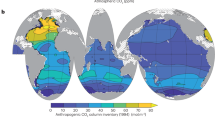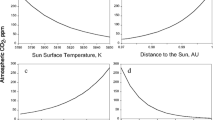Abstract
The notion is pervasive in the climate science community and in the public at large that the climate impacts of fossil fuel CO2 release will only persist for a few centuries. This conclusion has no basis in theory or models of the atmosphere/ocean carbon cycle, which we review here. The largest fraction of the CO2 recovery will take place on time scales of centuries, as CO2 invades the ocean, but a significant fraction of the fossil fuel CO2, ranging in published models in the literature from 20–60%, remains airborne for a thousand years or longer. Ultimate recovery takes place on time scales of hundreds of thousands of years, a geologic longevity typically associated in public perceptions with nuclear waste. The glacial/interglacial climate cycles demonstrate that ice sheets and sea level respond dramatically to millennial-timescale changes in climate forcing. There are also potential positive feedbacks in the carbon cycle, including methane hydrates in the ocean, and peat frozen in permafrost, that are most sensitive to the long tail of the fossil fuel CO2 in the atmosphere.
Article PDF
Similar content being viewed by others
Avoid common mistakes on your manuscript.
References
Alley RB, Clark PU, Huybrechts P, Joughin I (2005) Ice-sheet and sea-level changes. Science, 310:456–471
Archer DE (1991) Modeling the calcite lysocline. J Geophys Res 96(C9):17,037–17,050
Archer D (2005) Fate of fossil-fuel CO2 in geologic time. J Geophysical Res Oceans 10:C09S05 DOI 10.1029/2004JC002625
Archer DE (2007) Methane hydrate stability and anthropogenic climate change. Biogeosciences 4:993–1057
Archer DE, Buffett B (2005) Time-dependent response of the global ocean clathrate reservoir to climatic and anthropogenic forcing. Geochem Geophys Geosys 6(3):Q03002 DOI 10.1029/2004GC000854
Archer D, Ganapolski A (2005) A movable trigger: Fossil fuel CO2 and the onset of the next glaciation. Geochem Geophys Geosys 6:Q05003 DOI 10.1029/2004GC000891
Archer D, Kheshgi H, Maier-Reimer E (1998) Dynamics of fossil fuel CO2 neutralization by marine CaCO3. Glob Biogeochem Cycles 12:259–276
Bamber JL, Alley RB, Joughin I (2007) Rapid response of modern day ice sheets to external forcing. Earth Planet Sci Lett 257:1–13
Berner RA, Kothavala Z (2001) GEOCARB III: a revised model of atmospheric CO2 over Phanerozoic time. Am J Sci 301(2):182–204
Berner BA, Lasaga AC, Garrels RM (1983) The carbonate–silicate geochemical cycle and its effect on atmospheric carbon dioxide over the past 100 million years. Am J Sci 283:641–683
Brewer PG, Paull C, Peltzer ET, Ussler W, Rehder G, Friederich G (2002) Measurements of the fate of gas hydrates during transit through the ocean water column. Geophys Res Lett 29(22):2081
Broecker WS, Takahashi T (1978) Neutralization of fossil fuel CO2 by marine calcium carbonate. In: Andersen NR, Malahoff A (eds) The fate of fossil fuel CO2 in the oceans. Plenum, New York, pp 213–248
Brovkin V, Bendtsen J, Claussen M, Ganopolski A, Kubatzki C, Petoukhov V (2002) Carbon cycle, vegetation and climate dynamics in the Holocene: experiments with the CLIMBER-2 model. Glob Biogeochem Cycles 16(4):86–1 DOI 10.1029/2001GB001662
Brovkin V, Ganopolski A, Archer D, Rahmstorf S (2007) Lowering of glacial atmospheric CO2 in response to changes in oceanic circulation and marine biogeochemistry. Paleoceanography 22, PA4202, DOI 10.1029/2006PA001380
Caldeira K (1995) Long-term control of atmospheric carbon-dioxide—low-temperature sea-floor alteration or terrestrial silicate-rock weathering. Am J Sci 295(9):1077–1114
Caldeira K, Rau GH (2000) Accelerating carbonate dissolution to sequester carbon dioxide in the ocean: geochemical implications. Geophys Res Lett 27(2):225–228
Caldeira K, Wickett ME (2005) Ocean model predictions of chemistry changes from carbon dioxide emissions to the atmosphere and ocean. J Geophys Res—Oceans 110(C9):C09S04.1–C09S04.12
Canadell JG, Quere CL, Raupach MR, Field CB, Buitehuis ET, Ciais P, Conway TJ, Gillett NP, Houghton RA, Marland G (2007) Contributions to accelerating atmospheric CO2 growth from economic activity, carbon intensity, and efficiency of natural sinks. Proc Natl Acad Sci USA 104(24):10288–10293
Clark PU, McCabe AM, Mix AC, Weaver AJ (2004) Rapid rise of sea level 19,000 years ago and its global implications. Science 304(5674):1141–1144
Crutzen PJ (2006) Albedo enhancement by stratospheric sulfur injections: a contribution to resolve a policy dilemma? Clim Change 77(3–4):211–219
Deffeyes KS (2001) Hubbert’s Peak: the impending World Oil Shortage. Princeton University Press, Princeton, NJ, p 208
Dekant W (1996) Toxicology of chlorofluorocarbon replacements. Environ Health Perspect 104:75–83
Denman KL, Brasseur G, Chidthaisong A, Ciais P, Cox PM, Dickinson RE, Hauglustaine D, Heinze C, Holland E, Jacob D, Lohmann U, Ramachandran S, Dias PLdS, Wofsy SC, Zhang X (2007) Couplings between changes in the climate system and biogeochemistry. In: Solomon S, Qin D, Manning M, Chen Z, Marquis M, Averyt KB, Tignor M, Miller HL (eds) Climate change 2007: the Physical Science basis. Contribution of Working Group I to the Fourth Assessment Report of the Intergovernmental Panel on Climate Change. Cambridge University Press, Cambridge, UK
Ekstrom G, Nettles M, Tsai VC (2006) Seasonality and increasing frequency of Greenland glacial earthquakes. Science 311:1756–1758
Ganopolski A, Rahmstorf S, Petoukhov V, Claussen M (1998) Simulation of modern and glacial climates with a coupled global model of intermediate complexity. Nature 371:323–326
Goodwin P, Williams RG, Follows MJ, Dutkeiwicz S (2007) The ocean–atmosphere partitioning of anthropogenic carbon dioxide on centennial timescales. Glob Biogeochem Cycles 21:GB1014 DOI 10.1029/2006GB002810
Hansen J, Nazarenko L, Ruedy R, Sato M, Willis J, Del Genio A, Koch D, Lacis A, Lo K, Menon S, Novakov T, Perlwitz J, Russell G, Schmidt GA, Tausnev N (2005) Earth’s energy imbalance: confirmation and implications. Science 308(5727):1431–1435
Hansen J, Sato M, Ruedy R, Lo K, Lea DW, Medina-Elizade M (2006) Global temperature change. Proc Natl Acad Sci USA 103(39):14288–14293
Hansen JE (2006) Avoiding climate change. Science 311(5760):469–470
Harvey LDD, Huang Z (1995) Evaluation of the potential impact of methane clathrate destabilization on future global warming. J Geophys Res 100:2905–2926
Jansen E, Overpeck J, Briffa KR, Duplessy J-C, Joos F, Masson-Delmotte V, Olago D, Otto-Bliesner B, Peltier WR, Rahmstorf S, Ramesh R, Raynaud D, Rind D, Solomina O, Villaalba R, Zhang D (2007) Paleoclimate. In: Solomon S, Qin D, Manning M, Chen Z, Marquis M, Averyt KB, Tignor M, Miller HL (eds) Climate Change 2007: the Physical Science basis. Contribution of Working Group I to the Fourth Assessment Report of the Intergovernmental Panel on Climate Change. Cambridge University Press, Cambridge, UK
Keeling CD (1961) The concentration and isotopic abundances of carbon dioxide in rural and marine air. Geochim Cosmochim Acta 24(3–4):277–298
Kirhner G, Noack C (1988) Core history and nuclide inventory of Chernobyl core at the time of accident. Nucl Saf 29(1):1–5
Kvenvolden KA (1988) Methane hydrate—a major reservoir of carbon in the shallow geosphere. Chem Geol 71(1–3):41–51
Lenton TM, Britton C (2006) Enhanced carbonate and silicate weathering accelerates recovery from fossil fuel CO2 perturbations. Glob Biogeochem Cycles 20:GB3009 DOI 10.1029/2005GB002678
Liblik LK, Moore TR, Bubier JL, Robinson SD (1997) Methane emissions from wetlands in the zone of discontinuous permafrost: Fort Simpson, Northwest Territories, Canada. Glob Biogeochem Cycles 11(4):485–494
Martin P, Archer D, Lea D (2005) Role of deep sea temperatures in the carbon cycle during the last glacial. Paleoceanography 20:2015 DOI 10.1029/2003PA000914
McGranahan G, Balk D, Anderson B (2007) The rising tide: assessing the risks of climate change and human settlements in low elevation coastal zones. Environ Urban 19(1):17–37
Milkov AV (2004) Global estimates of hydrate-bound gas in marine sediments: how much is really out there? Earth-Sci Rev 66(3–4):183–197
Montenegro A, Brovkin V, Eby M, Archer D, Weaver AJ (2007) Long term fate of anthropogenic carbon. Geophys Res Lett 34:L19707 DOI 10.1029/2007GL030905
Oppenheimer M (1998) Global warming and the stability of the West Antarctic Ice Sheet. Nature 393(6683):325–332
Revelle R, Suess HE (1957) Carbon dioxide exchange between atmosphere and ocean and the question of an increase of atmospheric CO2 during the past decades. Tellus 9:18–27
Ridgwell A, Hargreaves JC (2007) Regulation of atmospheric CO2 by deep-sea sediments in an Earth system model. Glob Biogeochem Cycles 21:GB2008 DOI 10.1029/2006GB002764
Rivkina E, Laurinavichius K, McGrath J, Tiedje J, Shcherbakova V, Gilichinsky D (2004) Microbial life in permafrost. Adv Space Res 33:1215–1221
Rivkina EM, Friedmann EI, McKay CP, Gilichinsky DA (2000) Metabolic activity of permafrost bacteria below the freezing point. Appl Environ Microbiol 66(8):3230–3233
Rogner H-H (1997) An assessment of world hydrocarbon resources. Annu Rev Energy Environ 22:217–262
Scheffer M, Brovkin V, Cox P (2006) Positive feedback between global warming and atmospheric CO2 concentration inferred from past climate change. Geophys Res Lett 33:L10702 DOI 10.1029/2005GL025044
Schellnhuber HJ, Cramer W, Nakicenovic N, Wigley T, Yohe G (2006) Avoiding dangerous climate change. Cambridge University Press, New York
Soden BJ, Wetherald RT, Stenchikov GL, Robock A (2002) Global cooling after the eruption of Mount Pinatubo: a test of climate feedback by water vapor. Science 296:727–730
Solomon S, Qin D, Manning M, Alley RB, Berntsen T, Bindoff NL, Chen Z, Chidthaisong A, Gregory JM, Hegerl GC, Heimann M, Hewitson B, Hoskins BJ, Joos F, Jouzel J, Kattsov V, Lohmann U, Matsuno T, Molina M, Nicholls N, Overpeck J, Raga G, Ramaswamy V, Ren J, Rusticucci M, Somerville R, Stocker TF, Whetton P, Wood RA, Wratt D (2007) Technical summary. In: Solomon S, Qin D, Manning M, Chen Z, Marquis M, Averyt KB, Tignor M, Miller HL (eds) Climate Change 2007: the Physical Science basis. Contribution of Working Group I to the Fourth Assessment Report of the Intergovernmental Panel on Climate Change. Cambridge University Press, Cambridge, UK
Stockstad E (2004) Defrosting the carbon freezer of the North. Science 304:1618–1620
Sundquist ET (1990) Influence of deep-sea benthic processes on atmospheric CO2. Phil Trans R Soc Lond A 331:155–165
Sundquist ET (1991) Steady-state and non-steady-state carbonate silicate controls on atmospheric CO2. Quat Sci Rev 10(2–3):283–296
Tans PP, Bakwin PS (1995) Climate-change and carbon-dioxide forever. Ambio 24(6):376–378
Torn MS, Harte J (2006) Missing feedbacks, asymmetric uncertainties, and the underestimation of future warming. Geophys Res Lett 33:L10703 DOI 10.1029/2005GL025540
Tsai WT (2005) An overview of environmental hazards and exposure risk of hydrofluorocarbons (HFCs). Chemosphere 61(11):1539–1547
Tyrrell T, Shepherd JG, Castle S (2007) The long-term legacy of fossil fuels. Tellus 59:664–672
Walker JCG, Kasting JF (1992) Effects of fuel and forest conservation on future levels of atmospheric carbon dioxide. Palaeogeogr, Palaeoclimatol, Palaeoecol (Global and Planetary Change Section) 97:151–189
Walker JCG, Hays PB, Kasting JF (1981) A negative feedback mechanism for the long-term stabilization of Earth’s surface temperature. J Geophys Res 86:9776–9782
Walter KM, Zimov SA, Chanton JP, Verbyla D, Chapin FS (2006) Methane bubbling from Siberian thaw lakes as a positive feedback to climate warming. Nature 443:71–75 DOI 10.1038/nature0504
Zwally HJ, Abdalati W, Herring T, Larson K, Saba J, Steffen K (2002) Surface melt-induced acceleration of Greenland ice-sheet flow. Science 297(5579):218–222
Author information
Authors and Affiliations
Corresponding author
Rights and permissions
Open Access This is an open access article distributed under the terms of the Creative Commons Attribution Noncommercial License (https://creativecommons.org/licenses/by-nc/2.0), which permits any noncommercial use, distribution, and reproduction in any medium, provided the original author(s) and source are credited.
About this article
Cite this article
Archer, D., Brovkin, V. The millennial atmospheric lifetime of anthropogenic CO2 . Climatic Change 90, 283–297 (2008). https://doi.org/10.1007/s10584-008-9413-1
Received:
Published:
Issue Date:
DOI: https://doi.org/10.1007/s10584-008-9413-1




